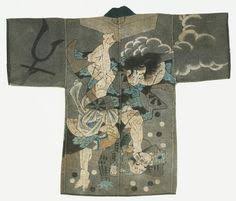History of the ‘Gi’

 I’ve often noticed a huge difference when training in regular clothes versus a Gi. Something happens to all of us when we put on the Gi and train. Its like our bodies know we have on our superhero clothing or something. It makes our technique feel stronger, puts us in the mood and feel of how a martial artist should look and perform. The actual term for a martial arts uniform is ‘KeikoGi’ which means practice clothing. In the early days of martial arts training, people often practiced in secret and privately. They wore what was available to them of the time, usually the garments wore under a Kimono.In 1907, Jigaro Kano, founder of Judo, developed the first uniform to be worn for the practice of Judo. Originally it was designed after Japanese Firemen’s 19th Century uniforms and made out of hemp.
I’ve often noticed a huge difference when training in regular clothes versus a Gi. Something happens to all of us when we put on the Gi and train. Its like our bodies know we have on our superhero clothing or something. It makes our technique feel stronger, puts us in the mood and feel of how a martial artist should look and perform. The actual term for a martial arts uniform is ‘KeikoGi’ which means practice clothing. In the early days of martial arts training, people often practiced in secret and privately. They wore what was available to them of the time, usually the garments wore under a Kimono.In 1907, Jigaro Kano, founder of Judo, developed the first uniform to be worn for the practice of Judo. Originally it was designed after Japanese Firemen’s 19th Century uniforms and made out of hemp.

Later cotton became the choice of fabric to use. Kano’s design of the Judo Uniform otherwise known as a ‘Judogi’ was the inspiration for other martial arts to develop similar uniforms, however specific to each art. It was Gichin Funakoshi who wore a JudogGi during a demonstration at the Kudokan and thus inspired a new look for practicing martial artists.
 Due to the demands of different martial arts, each uniform is slightly different. For example a JudoGi has longer sleeves, layered sleeves which withstand the grabbing and throwing that is part of Judo. Those uniforms are usually a heavier weight of material as well. Jiu Jitsu uniforms require a shorter jacket which helps to avoid lapel chokes and is also out of a heavier material. Karate and TaeKwon Do uniforms are lighter in weight and thinner which makes kicking much easier and there is more freedom of movement.
Due to the demands of different martial arts, each uniform is slightly different. For example a JudoGi has longer sleeves, layered sleeves which withstand the grabbing and throwing that is part of Judo. Those uniforms are usually a heavier weight of material as well. Jiu Jitsu uniforms require a shorter jacket which helps to avoid lapel chokes and is also out of a heavier material. Karate and TaeKwon Do uniforms are lighter in weight and thinner which makes kicking much easier and there is more freedom of movement.
 Modern day uniforms have definitely changed. There are different colours, fabrics, different weights of materials, designs etc. However the traditional white uniform is still a universal in many dojos. White was the chosen colour as it represents everyone as an equal, purity, simplicity and the lack of EGO. The ‘obi’ or belt was also a part of the uniform when Kano designed it. However, it originally was the belt of the Kimono to hold the pants up. The Gi and Obi are both two items that every martial artist should take care of and respect. For they represent the hard work and dedication to your martial art. Young martial artists should always be encouraged to take care of it and treat it with respect. Make sure its clean, ironed, badges sewn on correctly and no holes in it. It should never be thrown on the floor like a piece of trash, but folded or hung with the respect it deserves.
Modern day uniforms have definitely changed. There are different colours, fabrics, different weights of materials, designs etc. However the traditional white uniform is still a universal in many dojos. White was the chosen colour as it represents everyone as an equal, purity, simplicity and the lack of EGO. The ‘obi’ or belt was also a part of the uniform when Kano designed it. However, it originally was the belt of the Kimono to hold the pants up. The Gi and Obi are both two items that every martial artist should take care of and respect. For they represent the hard work and dedication to your martial art. Young martial artists should always be encouraged to take care of it and treat it with respect. Make sure its clean, ironed, badges sewn on correctly and no holes in it. It should never be thrown on the floor like a piece of trash, but folded or hung with the respect it deserves.
Tracy Warrener - Van Kruistum has been fortunate to have been raised within the Martial Arts since the age of 4 years old and is a 4th Degree Black Belt in Goju Ryu Karate. She has had the opportunity to study with some amazing Martial Artists. Sensei Richard Kim, Sensei Peter Urban, Professor Don Jacob, Sensei Jim Wilson, Professor Wally Jay, just to name several. Of course her main Sensei is her father, Sensei Don Warrener. Throughout the 40 plus years of her involvement in the Martial Arts, she has worked her way from being a student of the martial arts to a Martial Arts Sensei ,teaching hundreds of students. She has ran and managed martial arts schools teaching students of all ages, worked within the community teaching at fitness centres, schools, businesses and Women’s Shelters, the benefits of Karate. One the causes close to her heart is teaching and empowering young girls and women the importance of self defence and awareness. Her program called Look Strong! Act Strong! Be Strong! focuses on easy self defence techniques and mind self defence techniques. In 2013 she was awarded The Silver Lifetime Achievement Award in the Masters of the Martial Arts Hall of Fame in California for her contribution to Women in the Martial Arts. She is also a Certified Reflexologist and Reiki Master. She has starred in three of her own DVDs produced by Rising Sun Productions on Reiki, Reflexology and her Look Strong ,Act Strong ,Be Strong Self Defence Program. tracy.warrenerentertainment@gmail.com
http://www.warrenerentertainment.com/first-100-years-of-judo-dvd-download/

